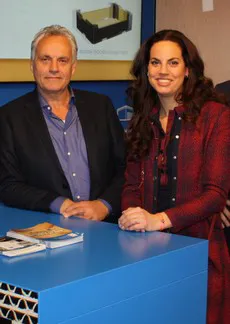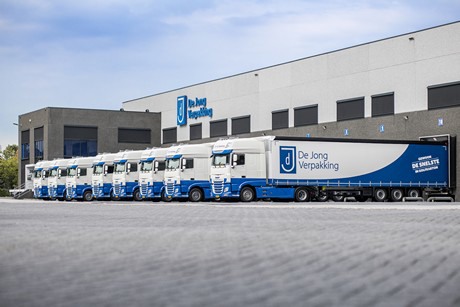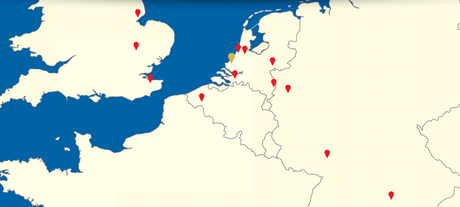Ever since De Jong Verpakking was founded in 1995, the company has been focused on expanding their volume. This specialist in corrugated cardboard packaging for fresh produce and industry has worked on expanding on various markets step by step, including fresh produce, flowers and plants, and the egg sectors.

Right from the start, the company’s strategy was to increase the market. This was partly realised by an increase in the core company, although the growth is also partially thanks to an increase due to the acquisition of other companies that were added to the group over the years. Not every candidate is suitable for De Jong Verpakking. A company has to fit the group regarding character and activities. With two new acquisitions, De Jong Verpakking is continuing to build a firm foundation in Northwestern Europe.
Henk de Jong with his daughter Merlin during Fruit Logistica
These most recent additions to De Jong Verpakking’s portfolio are Gaster Wellpappe, a producer of corrugated cardboard with branches in Heidelberg and Augsburg, and Rudico, a producer of preprint in Eerbeek. Preprint is preprinted paper that is turned into corrugated cardboard later. This way, the ribbed effect when printing directly onto corrugated cardboard is prevented. “It’s actually one of the best ways to create beautiful boxes,” says Henk de Jong, owner of De Jong Verpakking. “Rudico also makes plates for printing machines, so we have that in-house now as well. It was a good acquisition for us.”

Consumer packaging
Traditionally, De Jong has always been focused on transport packaging, although they have now also entered the market for consumer packaging. Henk has noticed quite a switch towards small packaging. Until recently, apples, tomatoes or bananas were practically exclusively packed in plastic, but cardboard trays and punnets for fruit and vegetables are now in high demand. “Cardboard is a very good alternative for plastic. It’s clean and renewable.” Although the market for small packaging is relatively new for De Jong, it also offers a lot of potential. “We’re getting so much demand from our current customers to help them think about cardboard consumer packaging, we’ll definitely be investing in it.”
Cardboard repacking for fresh produce
Henk argues to also consider repacking fresh produce in cardboard, besides using cardboard as consumer packaging. Cardboard offers a lot of benefits, mostly in the field of hygiene and optimising transport. Cardboard is clean because it’s new, and it doesn’t breed unwanted bacteria. Cardboard casks require less transport because they don’t weigh much, and because they are pressed together after use, so they can be recycled. Recycling occurs in the box’s destination country, the packaging doesn’t have to be returned to its country of origin.

But the transport of the filled cardboard outer box is more efficient as well. Boxes can be made to fit the exact size of the product to be packed, so that the entire box can be filled, but also so that the entire lorry can be filled, without having to transport air. “That’s a major benefit compared to plastic, which only features ten different sizes,” Henk explains. Currently, about half the retailers use cardboard for transport packaging. The other half chooses plastic casks.
Renewable
To produce corrugated cardboard, recycled paper supplemented with new paper is used most often. The new paper is made from Scandinavian and Eastern European wood. In these countries, you’re obligated to plant three new trees for every tree that is chopped down. “So the more paper we use, the more forests are created,” Henk says. Besides, 80 to 90 per cent of the cardboard is reused. Cardboard can be reused eight to ten times, then it starts losing strength. By always using a mix of new and recycled material, the paper can be reused many times. As an example, Henk mentions a tomato box that uses cardboard composed of five layers. One of these layers will be new paper, so that plenty of fibres are present for a firm final product.

Distinctive
Another advantage of using the boxes is that they can be printed, making them distinctive, and this allows customers to convey a message as well. De Jong Verpakking has noticed a need for companies to be distinctive. “You can be distinctive with a nicely printed box, particularly when you want to market your own brand.”
Speed
Henk mentions that speed of delivery is often essential for customers, specifically in the fresh produce sector, because the products are both fresh and perishable. The amount needed often becomes known only shortly before delivery of the boxes. One example is the tomato grower who might pick three kilos of tomatoes per square metre during a sunny week, but only 1.5 kilos when the weather isn’t as good. It makes a big difference for the number of packagings the grower needs. “That’s our strength - speedy delivery, on time delivery, plenty of stock and never saying no,” Henk concludes.
More information De Jong Verpakking
De Jong Verpakking
Jogchem v.d. Houtweg 20
2678 HA De Lier
T: +31 (0)186 573 990
Fax: +31 (0)186 573 967
info@dejongverpakking.nl
www.dejongverpakking.com
